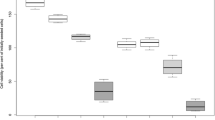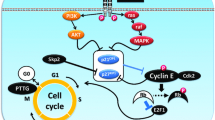Abstract
R-flurbiprofen, a nonsteroidal anti-inflammatory drug derivative, has been shown to inhibit colonic adenoma formation in mice. We investigated the effects of R-flurbiprofen on cell proliferation and apoptosis in pituitary adenoma cell lines. GH4C1 rat pituitary cell line cultures and low-passage human primary pituitary cell cultures were treated with varying concentrations of R-flurbiprofen (0.1–1.0 mM). R-flurbiprofen inhibited cell proliferation in a dose-dependent fashion. A terminal deoxynucleotidyl transferase dUTP nick end labeling assay and chromatin condensation/dead cell apoptosis assay demonstrated induction of apoptosis at higher concentrations of R-flurbiprofen. R-flurbiprofen decreases cell proliferation and induces apoptosis in pituitary adenoma cells in vitro. This may be a potential therapy in the management of pituitary adenoma.





Similar content being viewed by others
References
Kovacs K, Horvath W (1986) Tumors of the pituitary gland. In: Atlas of tumor pathology (Second Series, Fascicle 21). Armed Forces Institute of Pathology, Washington DC
Ragel BT, Jensen RL, Gillespie DL, Prescott SM, Couldwell WT (2007) Celecoxib inhibits meningioma tumor growth in a mouse xenograft model. Cancer 109:588–597
Chan G, Boyle JO, Yang EK, Zhang F, Sacks PG, Shah JP, Edelstein D, Soslow RA, Koki AT, Woerner BM, Masferrer JL, Dannenberg AJ (1999) Cyclooxygenase-2 expression is up-regulated in squamous cell carcinoma of the head and neck. Cancer Res 59:991–994
Wechter WJ, Kantoci D, Murray ED Jr, Quiggle DD, Leipold DD, Gibson KM, McCracken JD (1997) R-flurbiprofen chemoprevention and treatment of intestinal adenomas in the APCMin/+ mouse model: implications for prophylaxis and treatment of colon cancer. Cancer Res 57:4316–4324
Wechter WJ, Leipold DD, Murray ED Jr, Quiggle D, McCracken JD, Barrios RS, Greenberg NM (2000) E-7869 (R-flurbiprofen) inhibits progression of prostate cancer in the TRAMP mouse. Cancer Res 60:2203–2208
Grosch S, Tegeder I, Schilling K, Maier TJ, Niederberger E, Geisslinger G (2003) Activation of c-Jun-N-terminal-kinase is crucial for the induction of a cell cycle arrest in human colon carcinoma cells caused by flurbiprofen enantiomers. FASEB J 17:1316–1318
Geisslinger G, Schaible HG (1996) New insights into the site and mode of antinociceptive action of flurbiprofen enantiomers. J Clin Pharmacol 36:513–520
Geisslinger G, Muth-Selbach U, Coste O, Vetter G, Schrodter A, Schaible HG, Brune K, Tegeder I (2000) Inhibition of noxious stimulus-induced spinal prostaglandin E2 release by flurbiprofen enantiomers: a microdialysis study. J Neurochem 74:2094–2100
Wechter WJ, Murray ED Jr, Kantoci D, Quiggle DD, Leipold DD, Gibson KM, McCracken JD (2000) Treatment and survival study in the C57BL/6J-APCMin/+(Min) mouse with R-flurbiprofen. Life Sci 66:745–753
Budenholzer BR (2002) Are selective COX 2 inhibitors superior to traditional NSAIDs? Rofecoxib did not provide unequivocal benefit over traditional NSAIDs. BMJ 325:161 author reply 161
Metcalfe S, Dougherty S, McNee W (2003) Systematic review of celecoxib for osteoarthritis and rheumatoid arthritis. Celecoxib’s relative gastrointestinal safety is overstated. BMJ 326:334 author reply 334
McCracken JD, Wechter WJ, Liu Y, Chase RL, Kantoci D, Murray ED Jr, Quiggle DD, Mineyama Y (1996) Antiproliferative effects of the enantiomers of flurbiprofen. J Clin Pharmacol 36:540–545
Mosmann T (1983) Rapid colorimetric assay for cellular growth and survival: application to proliferation and cytotoxicity assays. J Immunol Methods 65:55–63
Zhang W, Lawa RE, Hintona DR, Su Y, Couldwell WT (1995) Growth inhibition and apoptosis in human neuroblastoma SK-N-SH cells induced by hypericin, a potent inhibitor of protein kinase C. Cancer Lett 96:31–35
Couldwell WT, Weiss MH, Law RE, Hinton DR (1995) Paradoxical elevation of Ki-67 labeling with protein kinase inhibition in malignant gliomas. J Neurosurg 82:461–468
van de Loosdrecht AA, Beelen RH, Ossenkoppele GJ, Broekhoven MG, Langenhuijsen MM (1994) A tetrazolium-based colorimetric MTT assay to quantitate human monocyte mediated cytotoxicity against leukemic cells from cell lines and patients with acute myeloid leukemia. J Immunol Methods 174:311–320
Twentyman PR, Luscombe M (1987) A study of some variables in a tetrazolium dye (MTT) based assay for cell growth and chemosensitivity. Br J Cancer 56:279–285
Gavrieli Y, Sherman Y, Ben-Sasson SA (1992) Identification of programmed cell death in situ via specific labeling of nuclear DNA fragmentation. J Cell Biol 119:493–501
Stadelmann C, Lassmann H (2000) Detection of apoptosis in tissue sections. Cell Tissue Res 301:19–31
Jung YJ, Isaacs JS, Lee S, Trepel J, Neckers L (2003) IL-1β-mediated up-regulation of HIF-1α via an NFκB/COX-2 pathway identifies HIF-1 as a critical link between inflammation and oncogenesis. FASEB J 17:2115–2117
Coussens LM, Werb Z (2002) Inflammation and cancer. Nature 420:860–867
Cao Y, Prescott SM (2002) Many actions of cyclooxygenase-2 in cellular dynamics and in cancer. J Cell Physiol 190:279–286
Vidal S, Kovacs K, Bell D, Horvath E, Scheithauer BW, Lloyd RV (2003) Cyclooxygenase-2 expression in human pituitary tumors. Cancer 97:2814–2821
Hinz B, Brune K (2002) Cyclooxygenase-2—10 years later. J Pharmacol Exp Ther 300:367–375
Williams CS, Tsujii M, Reese J, Dey SK, DuBois RN (2000) Host cyclooxygenase-2 modulates carcinoma growth. J Clin Invest 105:1589–1594
Tsujii M, Kawano S, Tsuji S, Sawaoka H, Hori M, DuBois RN (1998) Cyclooxygenase regulates angiogenesis induced by colon cancer cells. Cell 93:705–716
Liu XH, Kirschenbaum A, Yao S, Lee R, Holland JF, Levine AC (2000) Inhibition of cyclooxygenase-2 suppresses angiogenesis and the growth of prostate cancer in vivo. J Urol 164:820–825
Reddy BS, Hirose Y, Lubet R, Steele V, Kelloff G, Paulson S, Seibert K, Rao CV (2000) Chemoprevention of colon cancer by specific cyclooxygenase-2 inhibitor, celecoxib, administered during different stages of carcinogenesis. Cancer Res 60:293–297
Bloomer CW, Kenyon L, Hammond E, Hyslop T, Andrews DW, Curran WJ, Dicker AP (2003) Cyclooxygenase-2 (COX-2) and epidermal growth factor receptor (EGFR) expression in human pituitary macroadenomas. Am J Clin Oncol 26:S75–S80
Mestre JR, Chan G, Zhang F, Yang EK, Sacks PG, Boyle JO, Shah JP, Edelstein D, Subbaramaiah K, Dannenberg AJ (1999) Inhibition of cyclooxygenase-2 expression. An approach to preventing head and neck cancer. Ann N Y Acad Sci 889:62–71
Cianchi F, Cortesini C, Bechi P, Fantappie O, Messerini L, Vannacci A, Sardi I, Baroni G, Boddi V, Mazzanti R, Masini E (2001) Up-regulation of cyclooxygenase 2 gene expression correlates with tumor angiogenesis in human colorectal cancer. Gastroenterology 121:1339–1347
Gallo O, Franchi A, Magnelli L, Sardi I, Vannacci A, Boddi V, Chiarugi V, Masini E (2001) Cyclooxygenase-2 pathway correlates with VEGF expression in head and neck cancer. Implications for tumor angiogenesis and metastasis. Neoplasia 3:53–61
Shiff SJ, Qiao L, Tsai LL, Rigas B (1995) Sulindac sulfide, an aspirin-like compound, inhibits proliferation, causes cell cycle quiescence, and induces apoptosis in HT-29 colon adenocarcinoma cells. J Clin Invest 96:491–503
Goldberg Y, Nassif II, Pittas A, Tsai LL, Dynlacht BD, Rigas B, Shiff SJ (1996) The anti-proliferative effect of sulindac and sulindac sulfide on HT-29 colon cancer cells: alterations in tumor suppressor and cell cycle-regulatory proteins. Oncogene 12:893–901
Barnes CJ, Cameron IL, Hardman WE, Lee M (1998) Non-steroidol anti-inflammatory drug effect on crypt cell proliferation and apoptosis during initiation of rat colon carcinogenesis. Br J Cancer 77:573–580
Shao J, Fujiwara T, Kadowaki Y, Fukazawa T, Waku T, Itoshima T, Yamatsuji T, Nishizaki M, Roth JA, Tanaka N (2000) Overexpression of the wild-type p53 gene inhibits NF-κB activity and synergizes with aspirin to induce apoptosis in human colon cancer cells. Oncogene 19:726–736
Giardina C, Boulares H, Inan MS (1999) NSAIDs and butyrate sensitize a human colorectal cancer cell line to TNF-alpha and Fas ligation: the role of reactive oxygen species. Biochim Biophys Acta 1448:425–438
Jones MK, Wang H, Peskar BM, Levin E, Itani RM, Sarfeh IJ, Tarnawski AS (1999) Inhibition of angiogenesis by nonsteroidal anti-inflammatory drugs: insight into mechanisms and implications for cancer growth and ulcer healing. Nat Med 5:1418–1423
Hanif R, Pittas A, Feng Y, Koutsos MI, Qiao L, Staiano-Coico L, Shiff SI, Rigas B (1996) Effects of nonsteroidal anti-inflammatory drugs on proliferation and on induction of apoptosis in colon cancer cells by a prostaglandin-independent pathway. Biochem Pharmacol 52:237–245
Grosch S, Schilling K, Janssen A, Maier TJ, Niederberger E, Geisslinger G (2005) Induction of apoptosis by R-flurbiprofen in human colon carcinoma cells: involvement of p53. Biochem Pharmacol 69:831–839
Williams CS, Mann M, DuBois RN (1999) The role of cyclooxygenases in inflammation, cancer, and development. Oncogene 18:7908–7916
Vane JR (1971) Inhibition of prostaglandin synthesis as a mechanism of action for aspirin-like drugs. Nat New Biol 231:232–235
Joki T, Heese O, Nikas DC, Bello L, Zhang J, Kraeft SK, Seyfried NT, Abe T, Chen LB, Carroll RS, Black PM (2000) Expression of cyclooxygenase 2 (COX-2) in human glioma and in vitro inhibition by a specific COX-2 inhibitor, NS-398. Cancer Res 60:4926–4931
Quann EJ, Khwaja F, Zavitz KH, Djakiew D (2007) The aryl propionic acid R-flurbiprofen selectively induces p75NTR-dependent decreased survival of prostate tumor cells. Cancer Res 67:3254–3262
King JG Jr, Khalili K (2001) Inhibition of human brain tumor cell growth by the anti-inflammatory drug, flurbiprofen. Oncogene 20:6864–6870
Gavrilov V, Steiner M, Shany S (2005) The combined treatment of 1, 25-dihydroxyvitamin D3 and a non-steroid anti-inflammatory drug is highly effective in suppressing prostate cancer cell line (LNCaP) growth. Anticancer Res 25:3425–3429
Liu XH, Yao S, Kirschenbaum A, Levine AC (1998) NS398, a selective cyclooxygenase-2 inhibitor, induces apoptosis and down-regulates bcl-2 expression in LNCaP cells. Cancer Res 58:4245–4249
Zhang X, Morham SG, Langenbach R, Young DA (1999) Malignant transformation and antineoplastic actions of nonsteroidal antiinflammatory drugs (NSAIDs) on cyclooxygenase-null embryo fibroblasts. J Exp Med 190:451–459
Tegeder I, Pfeilschifter J, Geisslinger G (2001) Cyclooxygenase-independent actions of cyclooxygenase inhibitors. FASEB J 15:2057–2072
Baeuerle PA, Baltimore D (1996) NF-κB: ten years after. Cell 87:13–20
Tegeder I, Niederberger E, Israr E, Guhring H, Brune K, Euchenhofer C, Grosch S, Geisslinger G (2001) Inhibition of NF-κB and AP-1 activation by R- and S-flurbiprofen. FASEB J 15:2–4
Barnes PJ (2006) How corticosteroids control inflammation: Quintiles prize lecture 2005. Br J Pharmacol 148:245–254
Mamytbekova A, Rezabek K, Kacerovska H, Grimova J, Svobodova J (1986) Antimetastatic effect of flurbiprofen and other platelet aggregation inhibitors. Neoplasma 33:417–421
Mamytbekova A, Rezabek K, Grimova J, Svobodova J (1987) Inhibitory action of flurbiprofen and mopidamole on tumor lung metastasis formation in mice. Cancer Treat Rep 71:1089–1090
Geerts H (2007) Drug evaluation: (R)-flurbiprofen—an enantiomer of flurbiprofen for the treatment of Alzheimer’s disease. IDrugs 10:121–133
Galasko DR, Graff-Radford N, May S, Hendrix S, Cottrell BA, Sagi SA, Mather G, Laughlin M, Zavitz KH, Swabb E, Golde TE, Murphy MP, Koo EH (2007) Safety, tolerability, pharmacokinetics, and Aβ levels after short-term administration of R-flurbiprofen in healthy elderly individuals. Alzheimer Dis Assoc Disord 21:292–299
Konstan MW, Byard PJ, Hoppel CL, Davis PB (1995) Effect of high-dose ibuprofen in patients with cystic fibrosis. N Engl J Med 332:848–854
Acknowledgments
We thank Kristin Kraus, M.Sc., for editorial assistance in preparing this article and Bradley Weaver for assistance with image analysis.
Conflict of interest
The authors do not report any conflict of interest concerning the materials or methods used in this study or the findings specified in this article.
Author information
Authors and Affiliations
Corresponding author
Rights and permissions
About this article
Cite this article
Liu, J.K., Patel, S.K., Gillespie, D.L. et al. R-flurbiprofen, a novel nonsteroidal anti-inflammatory drug, decreases cell proliferation and induces apoptosis in pituitary adenoma cells in vitro. J Neurooncol 106, 561–569 (2012). https://doi.org/10.1007/s11060-011-0712-4
Received:
Accepted:
Published:
Issue Date:
DOI: https://doi.org/10.1007/s11060-011-0712-4




